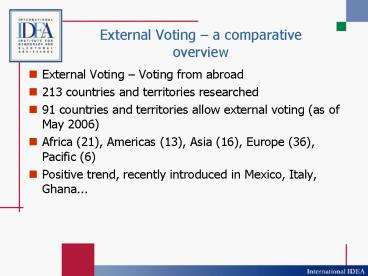External Voting a comparative overview PowerPoint PPT Presentation
1 / 20
Title: External Voting a comparative overview
1
External Voting a comparative overview
- External Voting Voting from abroad
- 213 countries and territories researched
- 91 countries and territories allow external
voting (as of May 2006) - Africa (21), Americas (13), Asia (16), Europe
(36), Pacific (6) - Positive trend, recently introduced in Mexico,
Italy, Ghana...
2
External Voting a comparative overview
- Provisions for external voting exist in 4
additional countries - not yet applied in
practise (Angola, Bolivia, Greece, Nicaragua,
Mozambique until recently). - Some additional countries and territories allow
external voting for local elections only. - Exceptional practice or abolishment of external
voting in i.e. Eritrea and East Timor
(referendums related to independence in 1993 and
1999 respectively) and Cambodia 1993 where it was
applied on a restrictive scale.
3
External Voting a comparative overview
- The Comparative Overview addresses three
variables - Who is entiltled to an external vote
- Which elections external voting applies to
- What are the voting methods for external voters
4
External Voting a comparative overview
- Who is entitled to an external vote?
- 65 countries and allow external voting for all
- 26 countries external voting restricted
associated to the voters activity and/or length
of stay abroad - 15 countries external voting restricted
associated to the length of stay abroad - Other restrictions intention to return
(Philippines), geography, nationality)
5
External Voting a comparative overview
- To which type of election does external voting
apply? - National elections only (51 countries)
- National and local elections (11 countries)
- National elections and referendums (19 countries)
- National and local elections and referendums (9
countries) - Referendums only (1 country)
- National elections include presidential elections
where applicable.
6
External Voting a comparative overview
- What are the voting methods for external voters?
- Voting in person (41 countries)
- Voting by mail (24 countries)
- Voting by proxy (1 country)
- Mixed (of the above) (25 countries)
- E-voting (Estonia, Netherlands...)
7
External Voting a comparative overview
- Electoral system, ballot paper design and
boundary delimitation design of external voting
practises - Reserved seats in 7 countries (Croatia, France,
Italy, Portugal, Cape verde, Mozambique,
Colombia)
8
External Voting a comparative overview
- A comparative overview
- The history and politics of external voting
- The legal framework and an overview of electoral
legislation - Entitlement to vote as an external voter
- The implementation of external voting
- External voting and participation
- Host country Issues
- The political rights of refugees and displaced
persons enfranchisement and participation
9
External Voting a comparative overview
- The political rights of migrant workers and
external voting - Observation of external voting
- E-voting and external voting
- Case studies Afghanistan, Bosnia and
Herzegovina, Botswana, Brazil, Cape Verde, Chad,
Colombia, Cook Islands, Dominican Republic,
Estonia, Honduras, Indonesia, Iraq, Marshall
islands, Mexico, Mozambique, The Philippines,
Portugal, Senegal, Switzerland, Zimbabwe.
10
Why a handbook?
- To provide tools, options and knowledge to those
involved in - Implementing external voting
- Introducing or discussing the introduction of
external voting - Improving existing external voting practises
- Debating external voting
- Election assistance and election observation
- Working on issues of political rights and
migration - Academics, media and others
11
E-voting as external voting - pros
- Convenience to external voters
- External voters as the ideal test group for
remote e-voting - Citizens abroad are well organized and capable
bringing their needs onto the agenda. - Remote e-voting might save costs.
12
E-voting as external voting - cons
- Security concerns
- Financial aspects
- Equal treatment of all voters (external and
internal)
13
e-voting and external voting France
14
e-voting and external voting Estonia
15
e-voting and external voting The Netherlands
16
e-voting and external voting New Zealand
17
e-voting and external voting Singapore
18
e-voting and external voting concluding remarks
- Voters abroad as a focus group for those
countries that are considering the introduction
of remote e-voting in. - Sometimes urgency for introducing e-voting for
external voters is bigger than for introducing it
for internal voters. - Practical difficulties
- No world-wide trend towards introducing remote
e-voting for external voting only a few
countries.
19
International IDEA
- Intergovernmental organisation, 24 member states
- Founded in 1995, financed through contributions
- To promote sustainable democracy worldwide
- Democracy building and conflict management
- Electoral processes
- Political parties
- Political equality and participation
- 55 staff, 30 nationalities
20
International IDEA
- Thank you!
- Maria Gratschew
- Electoral Processes Team
- Strömsborg
- 103 34 Stockholm
- Sweden
- Phone 46 8 698 37 00
- Fax 46 8 20 24 22
- m.gratschew_at_idea.int

